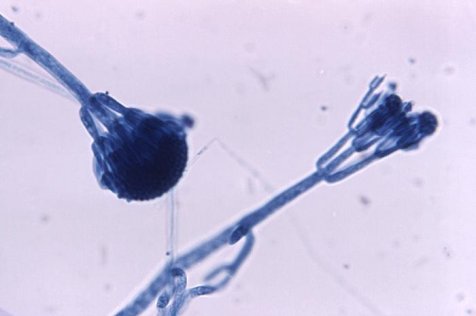
(Public domain image)
In 2008, plant pathologist Dr. Gary A. Strobel and his colleagues published a paper about an odd fungus (Gliocladium roseum) they found in a Patagonian rainforest. It is endophytic, which means it lives within a plant and takes nutrients from the plant, but it is not a parasite. Other endophytic fungi have been shown to produce all sorts of benefits to plants, including giving them much-needed chemicals and allowing them to communicate with one another, so this fungus probably gives some benefit to the plants in which it grows. However, that wasn’t the focus of Dr. Strobel’s paper. Instead, he and his colleagues noted that this fungus actually produced a wide variety of chemicals, including those found in diesel fuel! As the authors stated:1
The hydrocarbon profile of G. roseum contains a number of compounds normally associated with diesel fuel and so the volatiles of this fungus have been dubbed ‘myco-diesel’.
The prefix “myco” means “fungus,” so the authors basically were calling some of the chemicals that G. roseum produces “fungus diesel.”
Well, it seems that Dr. Strobel and his colleagues have been busy trying to coax G. roseum to make more “fungus diesel,” and they have produced some rather dramatic results. They built a tabletop device they call “The Paleobiosphere”2, which is supposed to mimic the conditions under which oil might form. It consists of two layers of shale, a type of rock that often contains oil. Sandwiched in between those two layers is a mixture of the fungus as well as leaves from maple, aspen, and sycamore trees. The container is flooded with water periodically, and in a mere three weeks, the shale layers contain a rich mixture of chemicals that is very similar to the oil found in the shales of Montana!
Now it is important to realize that while this mixture is similar to oil, it is not exactly the same as oil. As Strobel says:3
Not all of the hundreds of compounds found in diesel are present in this simple experiment, but representative molecules in each of the major classes of hydrocarbons are there.
So in the end, while the mixture of chemicals produced by The Paleobiosphere cannot be properly called “oil,” it is definitely “oil-like.”
This has some pretty important implications. Not surprisingly, Strobel and his colleagues are hoping to produce a useable fuel this way. Indeed, Strobel is working with a company called Endophytics, which is planning on patenting the process and scaling it up to make a commercially-viable fuel production facility. As the CEO of the company says:4
We just don’t have to sit here and assume that at some point there’s an end to oil.
Of course, this also has implications for discussions related to the age of the earth. It is commonly thought that oil takes millions of years to form. While young-earth creationists have already pointed out that laboratory experiments demonstrate this is not the case, it is useful to find out there is yet another process that forms an oil-like substance very quickly. In addition, The Paleobiosphere contains only the kinds of processes and components found in nature. As a result, it is a reasonable model for what could have happened in the past.
Is it a problem that the oil-like substance produced in The Paleobiosphere isn’t an exact match to oil? Not really. After all, the experiment took place over a mere three weeks and contained a very narrow mixture of plant matter. It would be very interesting to see how the oil-like substance changes if the process is allowed to continue for several years. In addition, I would think that what the fungus grows on would make a big difference in the final mixture of hydrocarbons produced. It would therefore be interesting to see what would happen if a much wider diversity of plant matter was used. Also, it would be interesting to see what would happen if animal remains were thrown into the mix as well.
While I am sure that the focus of Strobel and his colleagues is going to be the commercial production of fuel, I hope they do spend some time using The Paleobiosphere to mimic what might have happened in the past. I suspect that they will be able to “fine tune” the model to produce something that is almost indistinguishable from oil, as long as they invest some resources into the endeavor.
REFERENCES
1. Gary A. Strobel, Berk Knighton, Katreena Kluck, Yuhao Ren, Tom Livinghouse, Meghan Griffin, Daniel Spakowicz, and Joe Sears, “The production of myco-diesel hydrocarbons and their derivatives by the endophytic fungus Gliocladium roseum (NRRL 50072),” Microbiology 154:3319-3328, 2008
Return to Text
2. Strobel G, Booth E, Schaible G, Mends MT, Sears J, and Geary B., “The Paleobiosphere: a novel device for the in vivo testing of hydrocarbon producing-utilizing microorganisms.,” Biotechnology Letters 35(4):539-52, 2013
Return to Text
3. “Out of Oil? Just Add Fungi,” Science 341:827, 2013.
Return to Text
4. Ibid
Return to Text
For more information on the age of the earth, see How old is the earth?.

Fascinating! Scientists have been trying to do the same thing with diatoms for quite some time as well (http://www.academia.edu/735125/Milking_diatoms_for_sustainable_energy_biochemical_engineering_versus_gasoline-secreting_diatom_solar_panels)
Thanks, Evan. I hadn’t see that.